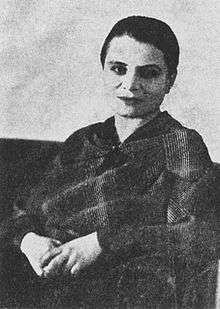Toyen


Marie Čermínová (21 September 1902, Prague – 9 November 1980, Paris), known as Toyen, was a Czech painter, drafter and illustrator and a member of the surrealist movement.
Biography
From 1919 to 1920, Toyen attended UMPRUM (Academy of Arts, Architecture and Design) in Prague. She worked closely with fellow Surrealist poet and artist Jindřich Štyrský until Štyrský's death. They joined the Devětsil group in 1923 and exhibited with the group. In the early 1920s Toyen travelled to Paris, and soon returned there with Štyrský. While living in Paris, the two founded an artistic alternative to Abstraction and Surrealism, which they dubbed Artificialism. They returned to Prague in 1928.
Toyen's sketches, book illustrations, and paintings were frequently erotic and she contributed erotic sketches for Štyrský's Eroticka Revue (1930–33). This journal was published on strict subscription terms based on a circulation of 150 copies. Štyrský also published books under the imprint Edice 69, some of which Toyen illustrated. For example, she illustrated the Marquis de Sade's Justine. Also of note, she contributed pieces in Die Frau als Künstlerin, Woman as an Artist, the prestigious 1928 survey of women artists in Western civilization.
Toyen and Štyrský gradually grew more interested in Surrealism. After their associates Vítězslav Nezval and Jindřich Honzl met André Breton in Paris, they founded the Czech Surrealist Group along with other artists, writers, and the composer Jaroslav Ježek.
Forced underground during the Nazi occupation and Second World War, she sheltered her second artistic partner, Jindřich Heisler, a poet of Jewish descent who had joined the Czech Surrealist Group in 1938. The two relocated to Paris in 1947, before the Communist takeover of Czechoslovakia in 1948. In Paris, they worked with André Breton, Benjamin Péret, and other surrealists.
Exploring Gender in Surrealism
Toyen was one of the Surrealists who were not cis men, along with Claude Cahun, Leonora Carrington and a handful of others.[1] While Cahun examined the fluidity of gender roles, Toyen dispensed with gender altogether. Toyen often dressed in men's clothing and preferred masculine pronouns, choosing a non-conformist position when it came to gender and sexuality, themes heavily mined in Surrealist art.[2]
References
- ↑ Surrealism, two private eyes : the Nesuhi Ertegun and Daniel Filipacchi Collections. Weisberger, Edward., Solomon R. Guggenheim Museum. New York, N.Y.: Guggenheim Museum. 1999. ISBN 9780810969216. OCLC 42047840.
- ↑ Huebner, Karla (Spring 2013). "In Pursuit of Toyen: Feminist Biography in an Art-Historical Context". Journal of Women's History. Volume 25, No. 1: 14–36 – via Project MUSE.
Scholarship
- Huebner, Karla Tonine. "Eroticism, Identity, and Cultural Context: Toyen and the Prague Avant-garde." Doctoral Dissertation, University of Pittsburgh, 2008.